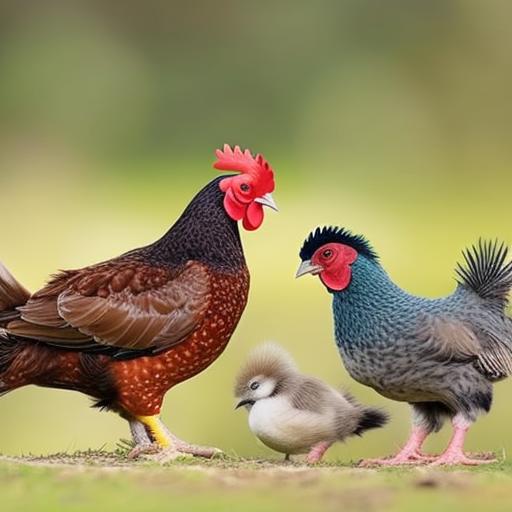Keeping different types of chickens together can be a rewarding and enjoyable experience for poultry enthusiasts. It allows for increased genetic diversity, better egg production, and a more colorful and interesting flock. However, it is important to have a good understanding of the factors to consider before mixing chicken breeds, as well as the challenges that may arise. By taking the time to research and plan, you can create a harmonious and thriving mixed flock.
Key Takeaways
- Keeping different types of chickens together can be beneficial for both the chickens and the owner.
- Factors such as breed size, temperament, and purpose should be considered before mixing chicken breeds.
- Understanding the pecking order and dominance hierarchy is important when introducing new chickens to an existing flock.
- Best practices for coop design and space management can help prevent conflicts and promote a healthy environment.
- Feeding and nutrition needs may vary between different chicken breeds, so it’s important to provide a balanced diet for all.
Benefits of Keeping Multiple Chicken Breeds Together
One of the main benefits of keeping different chicken breeds together is increased genetic diversity. This can lead to healthier and more resilient birds, as well as improved overall flock vitality. When chickens from different breeds are bred together, their offspring may inherit desirable traits from both parents, resulting in stronger and more adaptable birds.
Another advantage of mixing chicken breeds is better egg production. Different breeds have different laying patterns and egg sizes, so by having a variety of chickens in your flock, you can ensure a steady supply of eggs throughout the year. Additionally, some breeds are known for their exceptional egg-laying abilities, so incorporating them into your flock can boost overall productivity.
A mixed flock also adds visual interest to your backyard or farm. With different colors, patterns, and sizes, each breed brings its own unique charm to the flock. This can make chicken-keeping even more enjoyable and entertaining for both children and adults alike.
Furthermore, keeping multiple chicken breeds together can reduce the risk of disease. When all the birds in a flock are genetically similar, they are more susceptible to the same illnesses and parasites. By introducing different breeds with varying genetic backgrounds, you create a more diverse population that is less likely to be affected by a single disease or parasite outbreak.
Factors to Consider Before Mixing Chicken Breeds
Before mixing chicken breeds, there are several factors that need to be considered to ensure the well-being of the birds and the success of the flock. These factors include the size and temperament of different breeds, space requirements, availability of resources, and climate and weather conditions.
Size and temperament are important considerations when mixing chicken breeds. Some breeds are larger and more dominant, while others are smaller and more docile. It is important to choose breeds that are compatible in terms of size and temperament to avoid aggression and bullying within the flock. Mixing aggressive and non-aggressive breeds can lead to injuries and stress among the birds.
Space requirements are another crucial factor to consider. Different breeds have different space needs, so it is important to provide enough room for each bird to move around comfortably. Overcrowding can lead to stress, aggression, and the spread of diseases. Make sure your coop and run are spacious enough to accommodate all the chickens in your mixed flock.
Availability of resources such as food, water, and nesting boxes should also be taken into account. Each breed may have different dietary needs, so it is important to provide a balanced diet that meets the nutritional requirements of all the birds in your flock. Additionally, having multiple food and water sources can help prevent competition and ensure that all chickens have access to these essential resources.
Lastly, climate and weather conditions should be considered when mixing chicken breeds. Some breeds are more cold-hardy, while others are better suited for warmer climates. Make sure that the breeds you choose can tolerate the climate in your area to ensure their health and well-being.
Understanding Chicken Pecking Order and Dominance
In a mixed flock, it is important to understand the concept of the pecking order and how dominance affects flock dynamics. The pecking order is a social hierarchy that chickens establish within their flock. It determines which birds have priority access to resources such as food, water, and nesting spots.
The pecking order is established through a series of pecks, nudges, and displays of dominance. The more dominant birds will assert their authority by pecking or chasing the less dominant birds. This behavior is a natural instinct for chickens and helps maintain order within the flock.
It is important to note that some level of aggression and pecking is normal in a mixed flock. However, excessive aggression or bullying can be detrimental to the well-being of the birds. Signs of aggression and bullying include constant chasing, feather pecking, and injuries.
Tips for Introducing New Chickens to an Existing Flock
When introducing new chickens to an existing flock, it is important to follow a gradual and careful process to minimize stress and aggression. Here are some tips to help you successfully integrate new birds into your mixed flock:
1. Quarantine new birds before introducing them: It is important to quarantine new birds for at least two weeks before introducing them to your existing flock. This helps prevent the spread of diseases and allows you to observe the new birds for any signs of illness.
2. Gradual introduction process: Start by placing the new chickens in a separate but adjacent enclosure where they can see and hear each other without direct contact. After a few days, allow them to interact through a wire barrier or mesh fence. This allows the birds to establish a pecking order without physical harm.
3. Providing separate food and water sources: During the introduction process, provide separate food and water sources for the new chickens. This ensures that all birds have access to these essential resources without competition.
4. Monitoring for signs of stress or aggression: Keep a close eye on the behavior of both the new and existing chickens during the introduction process. Look out for signs of stress, such as excessive hiding or feather loss, as well as signs of aggression or bullying. If necessary, separate any overly aggressive birds to prevent injuries.
Common Challenges When Keeping Different Chicken Breeds Together

While keeping different chicken breeds together can be rewarding, there are some common challenges that may arise. It is important to be aware of these challenges and take appropriate measures to address them.
One common challenge is fighting and aggression within the flock. This can occur when there is a mismatch in size or temperament between the breeds. Aggressive behavior can lead to injuries and stress among the birds. If fighting becomes excessive, it may be necessary to separate the aggressive birds from the rest of the flock.
Another challenge is egg stealing. Some breeds may have a tendency to steal eggs from other hens’ nests. This can be frustrating and result in a decrease in egg production. To prevent egg stealing, provide multiple nesting boxes and ensure that they are well-hidden and comfortable for the hens.
Disease transmission is also a concern when keeping different chicken breeds together. Some breeds may be more susceptible to certain diseases or parasites, which can then spread to the rest of the flock. Regular health checks, proper hygiene practices, and quarantine procedures can help minimize the risk of disease transmission.
Unequal access to resources can also be a challenge in mixed flocks. Dominant birds may monopolize food, water, and nesting spots, leaving the less dominant birds at a disadvantage. Providing multiple feeding and watering stations, as well as ample space and resources, can help ensure that all birds have equal access to these essentials.
Best Practices for Coop Design and Space Management
To successfully keep different chicken breeds together, it is important to have a well-designed coop and proper space management. Here are some best practices to consider:
1. Providing enough space for each bird: Ensure that your coop and run have enough space to accommodate all the chickens in your mixed flock comfortably. Overcrowding can lead to stress, aggression, and the spread of diseases.
2. Separating aggressive birds: If you have aggressive birds in your flock, it may be necessary to separate them from the rest of the flock. This can be done by creating a separate enclosure within the coop or providing a separate coop altogether.
3. Providing multiple roosting areas: Chickens have a natural instinct to roost at night, so it is important to provide multiple roosting areas to accommodate all the birds. This helps prevent overcrowding and reduces the risk of aggression.
4. Keeping the coop clean and well-ventilated: Regular cleaning and disinfecting of the coop are essential for maintaining the health and hygiene of your mixed flock. Additionally, proper ventilation helps prevent the buildup of moisture and ammonia, which can lead to respiratory issues.
Health and Hygiene Considerations for Mixed Chicken Flocks
Maintaining the health and hygiene of your mixed chicken flock is crucial for their overall well-being. Here are some important considerations:
1. Regular cleaning and disinfecting: Regularly clean and disinfect your coop to prevent the buildup of bacteria, parasites, and diseases. Remove soiled bedding, clean surfaces with a poultry-safe disinfectant, and provide fresh bedding regularly.
2. Monitoring for signs of illness: Keep a close eye on your chickens for any signs of illness, such as changes in behavior, decreased appetite, or abnormal droppings. Promptly isolate any sick birds and seek veterinary advice if necessary.
3. Providing proper nutrition and supplements: Ensure that your mixed flock is receiving a balanced diet that meets their nutritional needs. Different breeds may have different dietary requirements, so it is important to provide a feed that is suitable for all birds. Additionally, supplementing with calcium for laying hens can help prevent eggshell problems.
4. Treating injuries and illnesses promptly: If any of your chickens become injured or ill, it is important to provide prompt treatment. This may involve cleaning wounds, administering medication, or seeking veterinary care when necessary.
Feeding and Nutrition Needs of Different Chicken Breeds
Different chicken breeds have different dietary needs, so it is important to provide a balanced diet that meets the nutritional requirements of all the birds in your mixed flock. Here are some considerations:
1. Different breeds have different dietary needs: Some breeds, such as meat birds, may require a higher protein content in their diet, while others, such as laying hens, may require more calcium. Research the specific dietary needs of each breed in your flock and choose a feed that meets those requirements.
2. Providing a balanced diet for all birds: Choose a feed that is suitable for all the birds in your mixed flock. This may involve selecting a feed that is appropriate for the majority of the birds and supplementing with additional nutrients as needed.
3. Supplementing with calcium for laying hens: Laying hens require extra calcium to produce strong eggshells. Provide oyster shell or crushed eggshells as a calcium supplement to ensure that your laying hens have access to this essential nutrient.
4. Avoiding toxic foods and plants: Some foods and plants can be toxic to chickens. Avoid feeding them foods such as chocolate, caffeine, onions, and avocados. Additionally, be cautious of plants in your yard or garden that may be toxic if ingested by chickens.
The Pros and Cons of Keeping Different Types of Chickens Together
In conclusion, keeping different types of chickens together can be a rewarding and enjoyable experience. It offers benefits such as increased genetic diversity, better egg production, and a more colorful and interesting flock. However, there are also challenges to consider, such as fighting and aggression, egg stealing, disease transmission, and unequal access to resources.
To successfully keep different chicken breeds together, it is important to do thorough research and planning. Consider factors such as size and temperament, space requirements, availability of resources, and climate conditions. Additionally, understanding the pecking order and dominance dynamics within the flock is crucial for maintaining a harmonious environment.
By following best practices for coop design and space management, as well as prioritizing the health and hygiene of your mixed flock, you can create a thriving and happy community of chickens. Remember to regularly monitor the health of your birds, provide a balanced diet, and promptly address any issues that arise. With proper care and attention, keeping different chicken breeds together can be a rewarding and fulfilling experience for poultry enthusiasts.
If you’re interested in learning more about keeping different types of chickens together, you might find this article on Poultry Wizard helpful. It provides valuable insights on the topic and offers practical advice on how to successfully integrate various chicken breeds in the same coop. Check it out here.
FAQs
What types of chickens can be kept together?
Different types of chickens can be kept together as long as they are of similar size and temperament. Some common breeds that can be kept together include Rhode Island Reds, Plymouth Rocks, and Wyandottes.
Can you keep roosters with hens of different breeds?
Yes, roosters can be kept with hens of different breeds as long as they are of similar size and temperament. However, it is important to note that roosters can be aggressive towards other roosters and may fight for dominance.
What should you consider before keeping different types of chickens together?
Before keeping different types of chickens together, you should consider their size, temperament, and purpose. Chickens that are too different in size may bully or harm each other, while chickens with different temperaments may not get along. Additionally, chickens that are raised for meat may not be compatible with those raised for egg production.
How should you introduce new chickens to an existing flock?
When introducing new chickens to an existing flock, it is important to do so gradually. Keep the new chickens in a separate area for a few days to allow them to get used to each other’s presence. Then, introduce them to the existing flock during the daytime when they are all awake and active. Monitor their interactions closely to ensure that there is no aggression or bullying.
What are the benefits of keeping different types of chickens together?
Keeping different types of chickens together can provide a variety of benefits. For example, it can help to increase genetic diversity, which can lead to healthier and more resilient flocks. Additionally, different breeds may have different strengths and weaknesses, which can help to balance out the flock as a whole. Finally, keeping different types of chickens together can be visually appealing and interesting.
Meet Walter, the feathered-friend fanatic of Florida! Nestled in the sunshine state, Walter struts through life with his feathered companions, clucking his way to happiness. With a coop that’s fancier than a five-star hotel, he’s the Don Juan of the chicken world. When he’s not teaching his hens to do the cha-cha, you’ll find him in a heated debate with his prized rooster, Sir Clucks-a-Lot. Walter’s poultry passion is no yolk; he’s the sunny-side-up guy you never knew you needed in your flock of friends!







